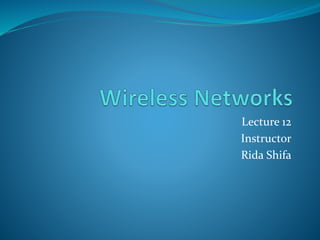
Switching Techniques Lecture12,wireless
- 2. Switching Terms Switching Nodes: Intermediate switching device that moves data Not concerned with content of data Stations: End devices that wish to communicate Each station is connected to a switching node Communications Network: A collection of switching nodes 2
- 4. Observations of Figure Some nodes connect only to other nodes (e.g., 5 and 7) Some nodes connect to one or more stations Node-station links usually dedicated point-to- point links Node-node links usually multiplexed links Frequency-division multiplexing (FDM) Time-division multiplexing (TDM) Not a direct link between every node pair 4
- 5. Techniques Used in Switched Networks Circuit switching Dedicated communications path between two stations E.g., public telephone network Packet switching Message is broken into a series of packets Each node determines next leg of transmission for each packet 5
- 6. Phases of Circuit Switching Circuit establishment An end to end circuit is established through switching nodes Information Transfer Information transmitted through the network Data may be analog voice, digitized voice, or binary data Circuit disconnect Circuit is terminated Each node deallocates dedicated resources 6
- 7. Characteristics of Circuit Switching Can be inefficient Channel capacity dedicated for duration of connection Utilization not 100% Delay prior to signal transfer for establishment Once established, network is transparent to users Information transmitted at fixed data rate with only propagation delay Propagation delay = d/s 7
- 8. Components of Public Telecommunications Network Subscribers - devices that attach to the network; mostly telephones Subscriber line - link between subscriber and network Also called subscriber loop or local loop Exchanges - switching centers in the network A switching centers that support subscribers is an end office Trunks - branches between exchanges 8
- 9. Example Connection Over a Public Circuit-Switching Network 9
- 11. How Packet Switching Works Data is transmitted in blocks, called packets Before sending, the message is broken into a series of packets Typical packet length is 1000 octets (bytes) Packets consists of a portion of data plus a packet header that includes control information At each node en route, packet is received, stored briefly and passed to the next node 11
- 13. Packet Switching Advantages Line efficiency is greater Many packets over time can dynamically share the same node to node link Packet-switching networks can carry out data-rate conversion Two stations with different data rates can exchange information Unlike circuit-switching networks that block calls when traffic is heavy, packet-switching still accepts packets, but with increased delivery delay Priorities can be used 13
- 14. Disadvantages of Packet Switching Each packet switching node introduces a delay Overall packet delay can vary substantially This is referred to as jitter Caused by differing packet sizes, routes taken and varying delay in the switches Each packet requires overhead information Includes destination and sequencing information Reduces communication capacity More processing required at each node 14
- 15. Packet Switching Networks - Datagram Each packet treated independently, without reference to previous packets Each node chooses next node on packet’s path Packets don’t necessarily follow same route and may arrive out of sequence Exit node restores packets to original order Responsibility of exit node or destination to detect loss of packet and how to recover 15
- 17. Packet Switching Networks – Datagram Advantages: Call setup phase is avoided Because it’s more primitive, it’s more flexible Datagram delivery is more reliable 17
- 18. Packet Switching Networks – Virtual Circuit Preplanned route established before packets sent All packets between source and destination follow this route Routing decision not required by nodes for each packet Emulates a circuit in a circuit switching network but is not a dedicated path Packets still buffered at each node and queued for output over a line 18
- 20. Packet Switching Networks – Virtual Circuit Advantages: Packets arrive in original order Packets arrive correctly Packets transmitted more rapidly without routing decisions made at each node 20
- 22. Assignment In the assignment , you people are going to submit: Where to use circuit switching? Where to use Packet switching? 22
- 23. 23
Editor's Notes
- propagation delay is equal to d / s where d is the distance and s is the wave propagation speed
- Jitter is any deviation in, or displacement of, the signal pulses in a high-frequency digital signal. overhead is any combination of excess or indirect computation time, memory, bandwidth, or other resources that are required to perform a specific task